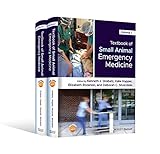Textbook of small animal emergency medicine / edited by Ken Drobatz, Kate Hopper, Elizabeth Rozanski, Deborah Silverstein.
Publisher: Hoboken, NJ : Wiley-Blackwell, 2019Description: 1 online resourceContent type:- text
- computer
- online resource
- 9781119028949
- 1119028949
- 9781119028956
- 1119028957
- 9781119028994
- 111902899X
- 636.089/6025 23
- SF778
- SF 778
Includes bibliographical references and index.
Description based on print version record and CIP data provided by publisher.
Intro; Textbook of Small Animal Emergency Medicine; Contents; Contributors; Dedication; Preface; About the Companion Website; Section 1 Emergency Medicine Overview; 1 Goals in Veterinary Emergency Medicine; The 40-Year Evolution of Goals in Veterinary Emergency Medicine; The Patient; The Client and the Team; Principles of Primary Survey, Resuscitation, Secondary Survey and Definitive or Refined Diagnostics and Treatment of Veterinary Emergency Patients; References; 2 Triage; Introduction; Telephone Triage; First Aid and Transport; Waiting Room Triage
Investigation and Stabilization of the PatientHistory; Emergency Physical Examination; Emergency Stabilization; References; Section 2 Common Conditions in Emergency Medicine; 3 Neurological Disorders; Initial Management of the Acute Neurological Patient; Neuroanatomic Localization; Initial Assessment; Consciousness; Posture and Body Position; Abnormal Movements; Ambulation and Gait; Cranial Nerves; Neurolocalization; Approach to Differential Diagnoses; References; 4 Respiratory Distress; Introduction; Does Oxygen Help?; Signalment; Any Relevant Past Medical History? What Has Happened Today?
Is There Hyperthermia or Hypothermia?Is There Loud Breathing?; Is There Any Cough or Wheeze?; Are There Extra Lung Sounds?; What Does Point-of-Care Ultrasound Show You?; What Should I Tell the Owner?; References; 5 Ventricular Ectopy; Introduction; Presentation; Diagnosis; Causes; Non-Cardiac Causes; Cardiac Causes; Treatment; Class I Antiarrhythmics; Class II Antiarrhythmics; Class III Antiarrhythmics; Other Antiarrhythmics; Defibrillation; 6 Acute Abdomen; History and Physical Examination; Clinical Pathology; Abdominal Imaging; Collection of Peritoneal Effusion
Analysis of Peritoneal EffusionAbdominal Surgery; Nutritional Support; Conclusion; References; 7 The Collapsed Patient; Introduction; Pathophysiology of Syncope; Causes of Syncope; Cardiac Syncope; Reflex-Mediated Syncope; Collapse or Syncope-Like Conditions; Patient Evaluation and Risk Stratification; Blood Pressure; ECG; Long-Term Monitoring; Bloodwork; Treatment; References; 8 Global Approach to the Trauma Patient; Introduction; Pathophysiology; Triage Evaluation and Intervention; Further Evaluation; Diagnostic Imaging; Conclusion; References; 9 Reproductive Emergencies; Introduction
Female Reproductive EmergenciesVaginal Discharge; Swollen Vulva or Mass Lesion; Reproductive Emergencies of the Pregnant Patient; Reproductive Emergencies of the Periparturient Patient; Male Reproductive Emergencies; Paraphimosis and Priapism; Prostate Disorders; Testicular Torsion; References; 10 Anemia; Introduction; Etiology; Consequences of Anemia; Clinical Signs; Diagnosis; History; Physical Examination; Laboratory Assessment; Diagnostic Approach; Decreased Erythropoiesis; Hemorrhagic Anemia; Hemolytic Anemia; References; 11 Jaundice; Definition; Physiology; Pathophysiology
There are no comments on this title.

